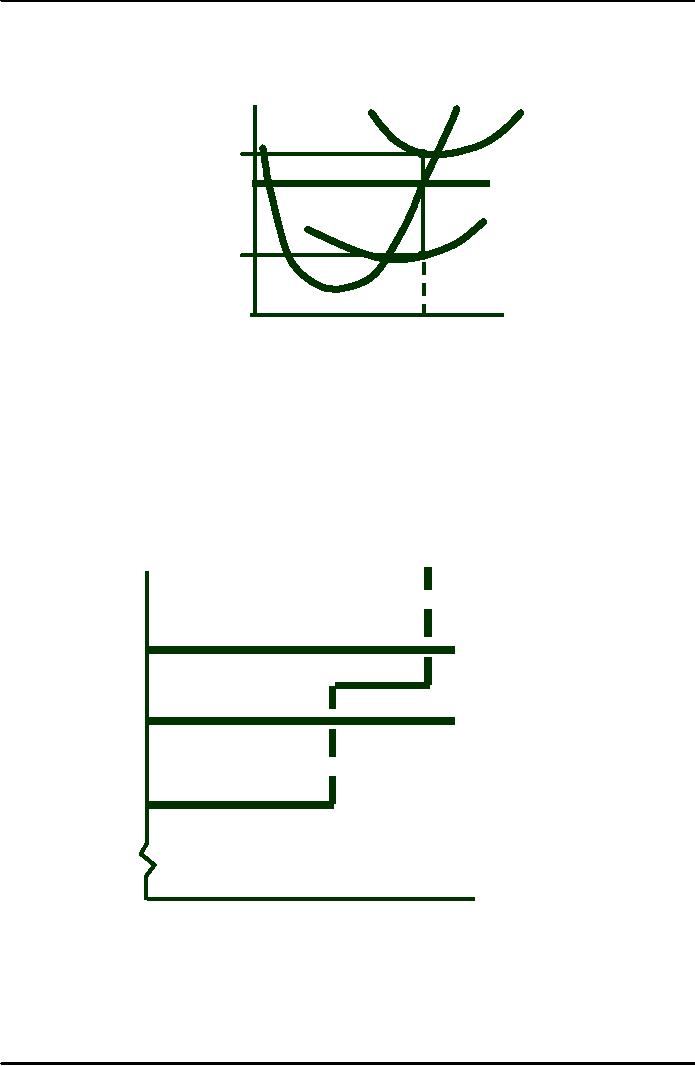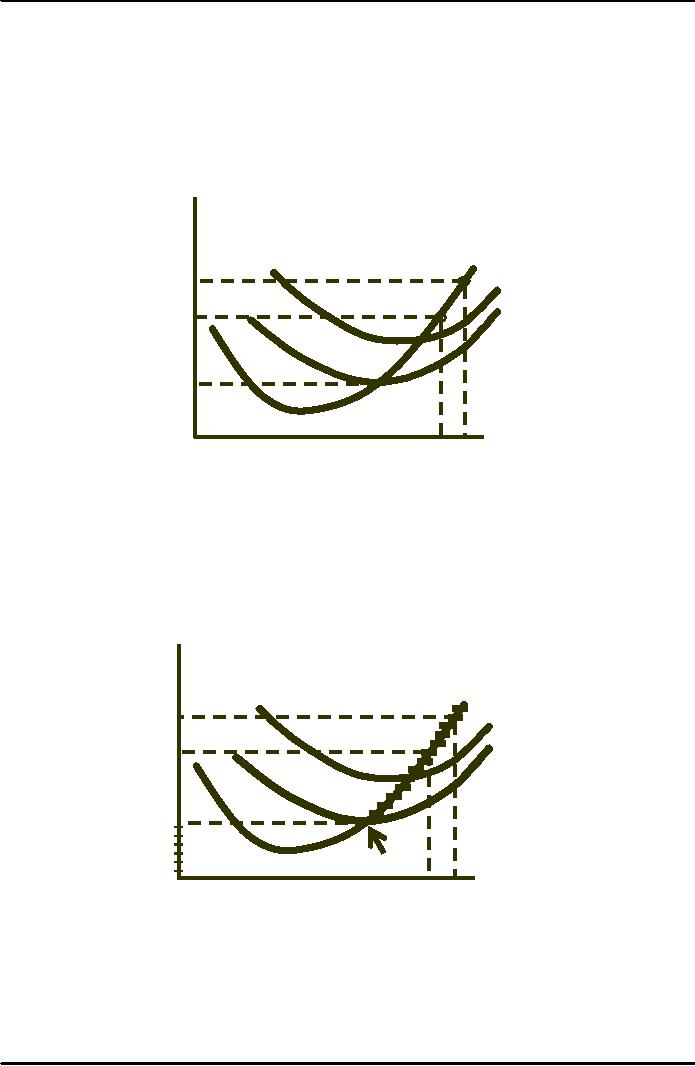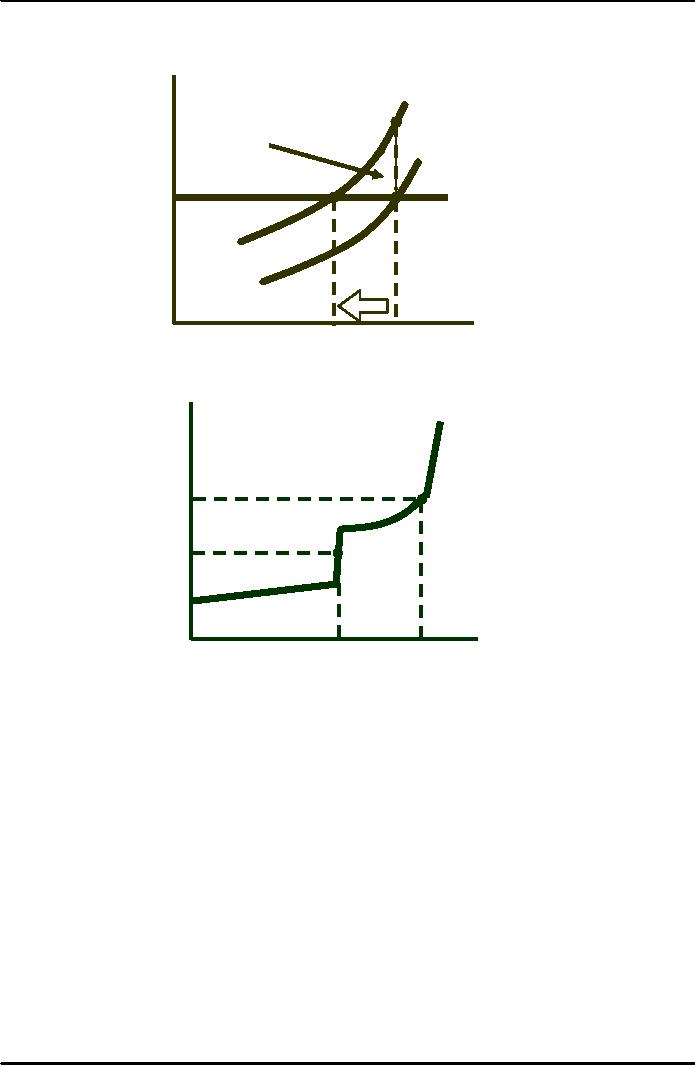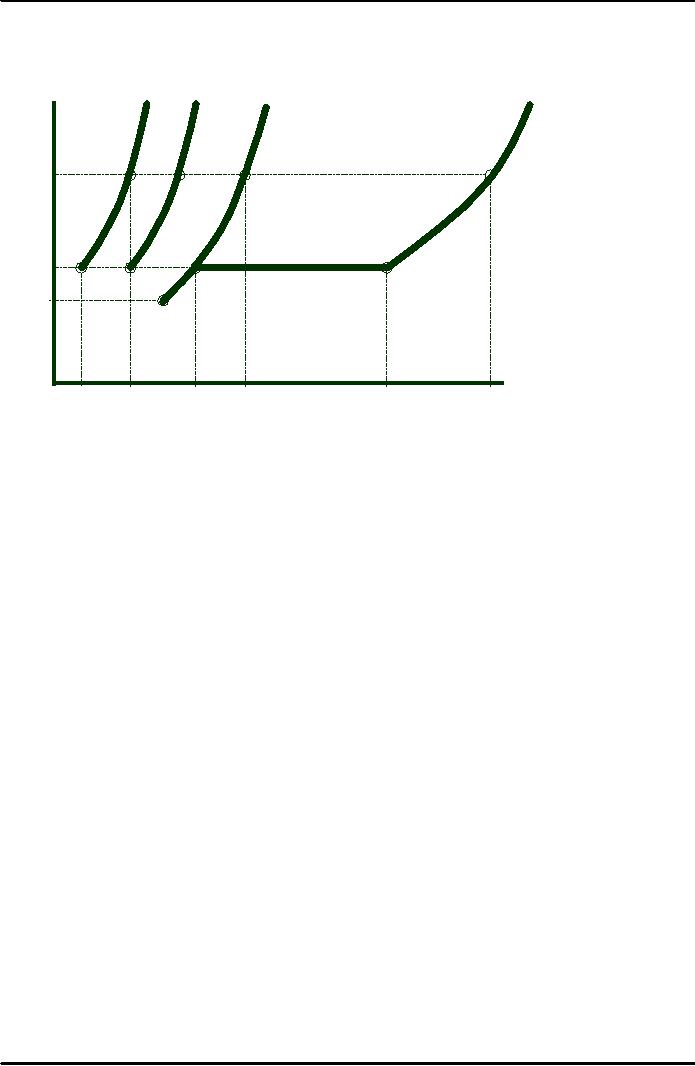 |
A Competitive Firm Incurring Losses:Industry Supply in Short Run |
| << Perfectly Competitive Markets:Choosing Output in Short Run |
| Elasticity of Market Supply:Producer Surplus for a Market >> |

Microeconomics
ECO402
VU
Lesson
23
A
Competitive Firm Incurring
Losses
M
AT
Price
($
per
unit)
B
C
P=
D
A
*
At
q :
MR = MC
and
P < ATC
AV
*
Losses
= P- AC) x q
or
ABCD
F
Would
this producer
E
continue
to produce
with
a loss?
Output
q
*
Choosing
Output in Short
Run
Summary
of Production Decisions
Profit is
maximized when MC
= MR
If P
> ATC the
firm is making profits.
If AVC
< P < ATC the
firm should produce at a
loss.
If P
< AVC < ATC the
firm should shut-down.
The
Short-Run Output of an Aluminum
Smelting Plant
Cost
Observations
∑Price between $1140 &
$1300: q
(dollars
per item)
=
600
∑Price > $1300:
q
=
900
1400
∑Price < $1140:
q
= 0
P
1300
P
1200
Question
1140
Should
the firm stay in
business
when
P
<
$1140?
1100
Output
0
(tons
per day)
300
600
900
Some
Cost Considerations for
Managers
Three
guidelines for estimating
marginal cost:
117

Microeconomics
ECO402
VU
1)
Average variable cost should
not be used as a substitute
for marginal cost.
2)
A single item on a firm's
accounting ledger may have
two components, only one
of
which
involves marginal
cost.
3)
All opportunity cost should
be included in determining marginal
cost.
A
Competitive Firm's Short-Run
Supply Curve
Price
($
per
The
firm chooses the output
level
unit)
where
MR = MC, as long as the
firm
is
able to cover its variable
cost of
MC
production.
ATC
P2
AVC
P1
What
happens
P
= AVC
if
P < AVC?
Output
q2
q1
Observations:
P
= MR
MR
= MC
P
= MC
Supply
is the amount of output for
every possible price.
Therefore:
If P = P1,
then q = q1
If P = P2,
then q = q2
Price
S
= MC above AVC
($
per
unit)
MC
ATC
P2
AVC
P1
P
= AVC
Shut-down
Output
q2
q1
Observations:
Supply is
upward sloping due to
diminishing returns.
Higher price
compensates the firm for
higher cost of additional
output and increases
total
profit because it applies to
all units.
Firm's
Response to an Input Price
Change
118

Microeconomics
ECO402
VU
When the
price of a firm's product
changes, the firm changes
its output level, so that
the
marginal
cost of production remains
equal to the price.
Price
MC2
($
per
Input
cost
unit)
Savings
to the firm
increases
from
reducing output
MC1 and
MC shifts
to
MC2
and
q falls
to q2.
$5
q
q2
Output
The
Short-Run Production of Petroleum
Products
The
MC of producing a mix
Cost
27
SMC
of
petroleum products
from
($
per
crude
oil increases sharply
at
barrel)
several
levels of output as
How
much would
the
refinery shifts from
one
be
produced if
26
processing
unit to another.
P
= $23?
P
=
$24-$25?
25
24
Output
23
(barrels/day)
8,000
9,000
10,000
11,000
Stepped
SMC indicates a different production
(cost) process at various
capacity levels.
Observation:
With a stepped
MC function, small changes in
price may not trigger a
change in output.
The
short-run market supply
curve shows the amount of
output that the industry
will
produce
in the short-run for every
possible price.
Consider,
for simplicity, a competitive
market with three
firms:
119

Microeconomics
ECO402
VU
Industry
Supply in Short
Run
The
short-run
$
per
MC1
MC2
MC3
S
industry
supply curve
unit
is
the horizontal
summation
of the supply
curves
of the firms.
P3
P2
P1
Question:
If increasing
output
raises input
costs,
what impact
would
it have on
market
supply?
Quantity
21
0
2
4 5
7 8
10
15
120
Table of Contents:
- ECONOMICS:Themes of Microeconomics, Theories and Models
- Economics: Another Perspective, Factors of Production
- REAL VERSUS NOMINAL PRICES:SUPPLY AND DEMAND, The Demand Curve
- Changes in Market Equilibrium:Market for College Education
- Elasticities of supply and demand:The Demand for Gasoline
- Consumer Behavior:Consumer Preferences, Indifference curves
- CONSUMER PREFERENCES:Budget Constraints, Consumer Choice
- Note it is repeated:Consumer Preferences, Revealed Preferences
- MARGINAL UTILITY AND CONSUMER CHOICE:COST-OF-LIVING INDEXES
- Review of Consumer Equilibrium:INDIVIDUAL DEMAND, An Inferior Good
- Income & Substitution Effects:Determining the Market Demand Curve
- The Aggregate Demand For Wheat:NETWORK EXTERNALITIES
- Describing Risk:Unequal Probability Outcomes
- PREFERENCES TOWARD RISK:Risk Premium, Indifference Curve
- PREFERENCES TOWARD RISK:Reducing Risk, The Demand for Risky Assets
- The Technology of Production:Production Function for Food
- Production with Two Variable Inputs:Returns to Scale
- Measuring Cost: Which Costs Matter?:Cost in the Short Run
- A Firmís Short-Run Costs ($):The Effect of Effluent Fees on Firmsí Input Choices
- Cost in the Long Run:Long-Run Cost with Economies & Diseconomies of Scale
- Production with Two Outputs--Economies of Scope:Cubic Cost Function
- Perfectly Competitive Markets:Choosing Output in Short Run
- A Competitive Firm Incurring Losses:Industry Supply in Short Run
- Elasticity of Market Supply:Producer Surplus for a Market
- Elasticity of Market Supply:Long-Run Competitive Equilibrium
- Elasticity of Market Supply:The Industryís Long-Run Supply Curve
- Elasticity of Market Supply:Welfare loss if price is held below market-clearing level
- Price Supports:Supply Restrictions, Import Quotas and Tariffs
- The Sugar Quota:The Impact of a Tax or Subsidy, Subsidy
- Perfect Competition:Total, Marginal, and Average Revenue
- Perfect Competition:Effect of Excise Tax on Monopolist
- Monopoly:Elasticity of Demand and Price Markup, Sources of Monopoly Power
- The Social Costs of Monopoly Power:Price Regulation, Monopsony
- Monopsony Power:Pricing With Market Power, Capturing Consumer Surplus
- Monopsony Power:THE ECONOMICS OF COUPONS AND REBATES
- Airline Fares:Elasticities of Demand for Air Travel, The Two-Part Tariff
- Bundling:Consumption Decisions When Products are Bundled
- Bundling:Mixed Versus Pure Bundling, Effects of Advertising
- MONOPOLISTIC COMPETITION:Monopolistic Competition in the Market for Colas and Coffee
- OLIGOPOLY:Duopoly Example, Price Competition
- Competition Versus Collusion:The Prisonersí Dilemma, Implications of the Prisoners
- COMPETITIVE FACTOR MARKETS:Marginal Revenue Product
- Competitive Factor Markets:The Demand for Jet Fuel
- Equilibrium in a Competitive Factor Market:Labor Market Equilibrium
- Factor Markets with Monopoly Power:Monopoly Power of Sellers of Labor